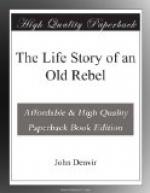There was one particularly daring couplet in it, the contribution of John McArdle:—
In your own Irish way give us one hearty
cheer.
Just to show us at once that you welcome
us here.
Had mine been the task to speak these lines, I must inevitably have failed to get the required response, but in the mouth of the regular reciter they never once missed fire. This was Mr. Barry Aylmer. He afterwards adopted the stage as a profession, and became recognised as a very fine actor, chiefly in Irish parts, as might be expected. He also travelled with a very successful entertainment of his own, and it is but a short time since he informed me that he spoke our identical “Emerald Minstrel” prologue in New York and other cities in America, adapting it, of course, to the circumstances of the occasion. I found that during the many years which had elapsed since I had previously seen him until I met him again quite recently he had been a great traveller, not only in this country and America, but also in South Africa and Australia.
We had a number of harmonized choruses, including several of Moore’s melodies, Banim’s “Soggarth Aroon,” “Native Music,” by Lover; McCann’s “O’Donnell Aboo!” and others. “Killarney,” words by Falconer, music by Balfe, was sung by James McArdle, who had a fine tenor voice. Richard Campbell was our principal humorous singer. He used chiefly to give selections from Lover’s songs, and one song written for him by John McArdle, “Pat Delany’s Christenin’.”
John had an instinctive grasp of stage effect. A hint of the possibilities of an idea was enough for him. On my return from the Curragh I told him of how I had heard the militia men and soldiers singing the “Shan Van Vocht” on the road. He decided that this should be our finale, the climax of the first part of our minstrel entertainment.
We had a drop scene representing the Lower Lake of Killarney. When it was raised it disclosed the interior of the living room of a comfortable Irish homestead, with the large projecting open chimney, the turf fire on the hearth, and the usual pious and patriotic pictures proper to such an interior—Terence’s Fireside.
Ours was a very self-contained company. Each had some special line as singer, musician, elocutionist, story teller or dancer.
John Clarke was our chief actor. He excelled in “character parts,” and, when well “made up” as an old man made a capital “Terence” in the first part of the entertainment, besides giving a fine rendering of Lefanu’s “Shemus O’Brien” between the parts.
In the miscellaneous part there was a rattling Irish jig by Joseph Ward and Barry Aylmer. The latter, being of somewhat slight figure and a good-looking youth, made a bouncing Irish colleen. These two made a point of studying from nature, not only in their dancing, but in their acting and singing, so that their performances were always true to life, without an atom of exaggeration. They were always received with great enthusiasm, particularly by the old people, who seemed transported back, as by the touch of a magic wand, to the scenes of their youth.




